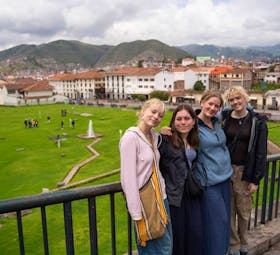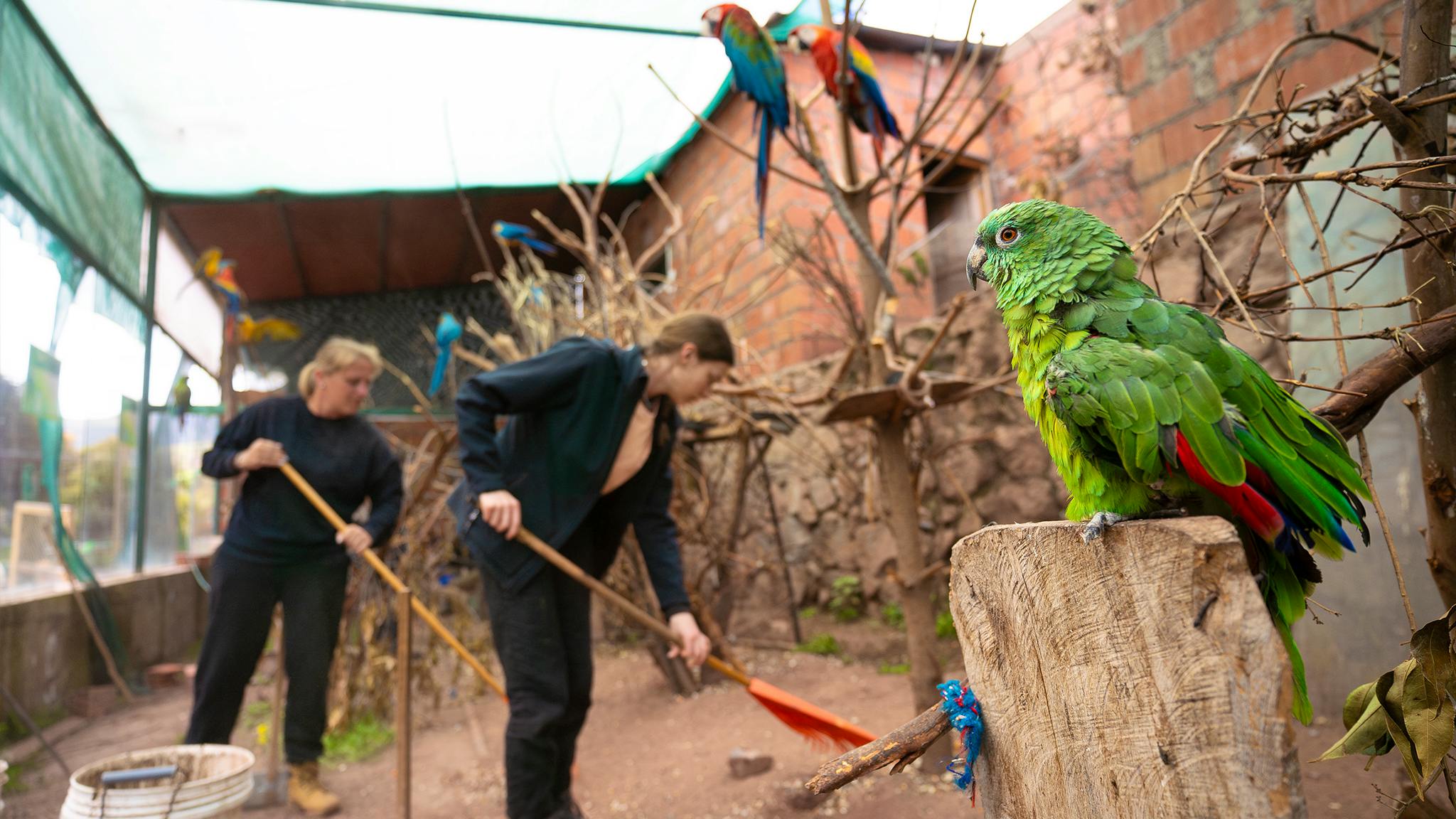As a Peru wildlife rescue volunteer, you will get up close and personal to some amazing animals. Not only this, PMGY’s Peru volunteer programs provide a great foundation to improve your Spanish. As a Peru wildlife volunteer, you will help care for a variety of different species of animals. Most noteworthy, animals who are endangered, poached or displaced from their natural habitat.
BACKGROUND TO THE WILDLIFE RESCUE PROGRAM
As in many South America countries, Peru is home to an abundance of wildlife. The sad reality is that much of this wildlife is vulnerable to wide-ranging forms of mistreatment. Examples include more localised problems such as abandonment or a failure to properly feed and house animals. However, wider-spread systematic forms of cruelty are also prevalent. For example, bestiality, illegal trafficking and raising animals to fight.
In 2015, the Peruvian Congress has passed animal cruelty laws which mandates criminal penalties for animal mistreatment. Since a series of animal-cruelty cases went viral. Naturally, this is not a good perception of Peru as a country or as a tourist hotspot. Such penalties for animal mistreatment range from fines to prison sentences.
However, many Peruvians would argue that more can be done and enforced by Congress and law enforcement in protecting Peru’s wildlife. Specifically, when it comes to wild animals, tourist traps and endangered species. Nowadays, there are many rescue centres and sanctuaries enforcing action upon themselves against animal mistreatment. The main mechanism to achieve this is through education.
Education is considered as the most important factor to contribute to wildlife conservation efforts. In addition, education is also the reason that justifies the existence of a wildlife sanctuary or wildlife rescue centre. Through engagement, information and communication, stronger respect and understanding for nature, wild animals and endangered species can be achieved. Not only this, but wildlife rescue centres also play a big role in recovery programs, animal rehabilitation and reproduction programs.
WILDLIFE RESCUE VOLUNTEER PLACEMENT EXAMPLE
Cochahuasi Animal Sanctuary - PMGY have teamed up with a family ran wildlife rescue centre in Cusco. The centre is dedicated to rescuing animals that have suffered any forms of mistreatment. For example, rescuing animals from illicit trafficking or those that have suffered physical neglect from former owners or evil poachers.
The rescued animals are put under the care of the forest rangers at the wildlife sanctuary. As a volunteer in Peru, you will play a vital role in supporting the forest rangers. In the same vein, as an animal volunteer you will work alongside the rangers to complete core tasks at the project. Such tasks for Peru wildlife volunteering include:
• Taking care of the animals
• Assisting with cleaning and general maintenance
• Support with feeding the animals
• Helping with any medical treatments required
• Assisting in any educational programs
• Help build new houses on-site
Since 2007, the wildlife rescue centre has been sheltering wild species. Moreover, many species are endangered. The Andean Condor receives special consideration at the centre and is the primary focus of the program. Most noteworthy, because its population has been seriously decimated in recent years. This is all inflicted by human activity. More specifically, the feathers of the bird are sold as souvenirs for tourists. This activity stimulates illegal hunting for these magnificent birds. Efforts at the centre are being made to encourage reproduction in captivity with the aim being to release the young Condors.
There is a range of other animals at the centre that you as a volunteer in Peru will encounter during your time. For example, pumas and small bears that had been drugged and used for entertainment purposes can usually be found here. In addition, there are many special types of birds to be found at the centre. A hawk who lost one of his eyes because of human hunting cannot hunt anymore in the wild and has been displaced to the centre. Other animals at the centre include foxes, turtles, monkeys, deer, alpacas, llamas and more!
On a broader level, the sanctuary has a range of programs that you as a Peru wildlife rescue volunteer can support with. For example, educational campaigns at local schools, recovery projects for sick and mistreated animals and reproduction programs for endangered animal species as exemplified with the Andean Condor.
Our Peru wildlife volunteering project allows volunteers and interns to experience their love of animals during their time in Peru. Working at the centre of the project as part of your international volunteering, your daily tasks will make a positive contribution. Moreover, the care and wellbeing these rescued animals receive will greatly improve. The sanctuary cares for all types of wildlife animals. Ultimately, the long-term aim of the project is to liberate the rescued animals back into natural environments.
Peru wildlife rescue volunteer projects typically receive little to no government funding or assistance. Therefore, volunteer support and contributions are a big help to the project that otherwise can receive limited help. By choosing to work closely with this wildlife project in Peru, your support as a Peru wildlife volunteer will be much appreciated by those connected at the sanctuary.
In short, if you have a love for wildlife, then this project is for you when visiting Peru! We have availability from 1 week to 4 weeks on the project. Furthermore, you will volunteer typically across the morning periods Monday-Friday. At this project, all animals have had their required vaccinations. Older clothing for Peru wildlife volunteering is recommended as are shoes that you do not mind getting dirty!
OTHER THINGS TO CONSIDER VOLUNTEERING WITH WILDLIFE IN PERU
Return Airport Transfer - Your return airport transfer is not included in your Program Fee. The most common method is to use a ridesharing app or private taxi service. Participants can often be travelling across their final few days and therefore are not necessarily heading back to the airport directly from our accommodation. The costs depend on your method of transport and your final destination. This can often be split across multiple participants if you are travelling with someone else on the program.
Spanish Requirements - For the wildlife program in Peru, we recommend that you speak a reasonable level of Spanish prior to your trip. There are no specific language requirements in order to join the program and you can join as an absolute beginner. However, we find that the ability to speak a good level of the Spanish language and a passion to learn more will greatly enhance your overall experience. This is because English is generally not widely spoken and therefore our programs should be viewed as a broader language immersion experience. If you do not speak a reasonable level of Spanish then you will find it difficult to communicate. As a result, this could lead to a more frustrating experience.
PMGY also offer Online Spanish Lessons that you can take before your trip. The lessons provide you with the opportunity to receive one-on-one classes from a trained Spanish teacher. Classes are held via Zoom and can be worked around your schedule back in your home country.
We also offer a learn Spanish in Peru program which you can take part in prior to your volunteer placement. This provides you with 20 hours-per-week of group Spanish lessons. Both of these options can be added during our online application process. They are highly recommended if you want to make the most of your volunteer placement.
Once you are in-country then you are also able to organise additional Spanish lessons directly with our local team. Volunteer feedback suggests that it can often be tiring to complete Spanish lessons at the same time as your volunteer programs in Peru. Consequently, we generally recommend extending your Language Immersion Program.
Experience - If you are a veterinary student you may be able to assist in more tasks. Naturally, this will depend on your level of knowledge, experience and qualifications in this area. You may be able to help with the sick, injured or disabled animals. Furthermore, there may be more opportunities in advanced veterinary care such as vaccinations or neutering procedures.
Project Donation - With each volunteer, there is a donation made directly to the volunteer project you join us in Peru. This donation fee is included in the Program Fee you pay PMGY.
With that donation, the project is provided with increased financial support to improve resources, infrastructure and project environment. Such beneficiaries being the patients at the medical clinics, students at the schools, children at the kindergartens or the dogs at the dog shelter project.
Weekends - Your project work in Peru runs from Monday-Friday and weekends are free. You are welcome to relax and hang out at the volunteer accommodation but most participants will use this time to travel and explore the country. As a result, you can check out our Peru Weekend Travel Guide for top tips on how to spend your weekend. We also run two separate weekend trips which you can sign-up to before you depart for Peru. We offer the Lake Titicaca & Islands Trip along with the Machu Picchu Trip with opportunities running every month.







 4.9
4.9











